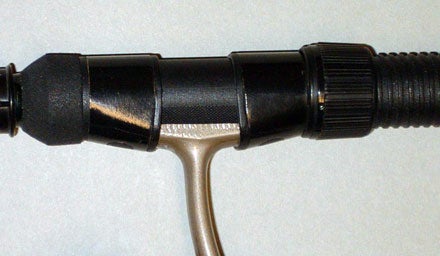Since my previous article on rod handles and the design of reel seats, I’ve had some further thoughts. I took the Edward de Bono approach using ‘Po’ as a starting point, whereby you disregard the present design and turn an idea completely on its head. However, no further ideas came leaping to mind as what other union between the two, the handle and the reel’s foot, would work quite as well. “You can analyse the past, but you must design the future!” – Edward de Bono (see website: www.edwarddebono.com) So, I quickly reached the conclusion that the present reel foot, on the reel itself, is almost perfect for the job. Being long it spreads it’s stress, such as it is, towards the front leg of the reel foot whilst the back part of the foot merely has to be trapped in order to keep it from falling away from the rod. It can’t be too wide either since the rod handle has only a certain diameter and any extra width wouldn’t buy you any extra advantage. So the width of the reel foot is in this case ideal. What do we want to do with the foot then? It can be much shorter in its length, that’s for sure. Presently, a reel foot measures between 2.25″ and 3″ (maybe even more on bigger sea reels) and this is partly because early designers must have believed that the stresses the rod and reel, together with the reel foot, faced were far greater than they actually are. Also, the only method of securing reel to rod at the time, they must have thought, was by the old two rings method. The way we should play a fish in the fight with the use of clutches and back-winding hardly puts any actual pressure on the reel’s foot at all, so making the reel’s purpose no more than a line store. The metals and carbons we’re using in reel body manufacture these days are perhaps very much stronger than were used in days gone by. This allows us to either slim down or shorten the foot altogether and if you shorten the foot, it means you can have a reel seat where the two halves of the handle fit closer together. So I am proposing an almost 50% reduction in the length of the reel foot from 2.25″ down to possibly just 1.25″ or thereabouts. Having done that, will the new reels fit existing rods? Some might, others might not. For example, those rods that rely on the old two rings (carbon or metal) to hold the reel in place still might, but other screw fittings, where the two halves are too far apart, certainly won’t. It could be a matter of trial and error, but if the reel seat on the rods were redesigned you would have a much closer fit and your hands would never need touch a cold part ever again. Look at the drawing at the top of the page. If the industry standardised on agreed specific measurements and perhaps three sizes, small (match/float), medium (spin/leger/specimen), large (pike/carp), then you would just buy a new rod and new reel of matching size. The spiral looking item in my design in front of the reel is the tightening mechanism, I have an American rod with a similar fitting already and the rubber grips means these are also warm to hold. Hey, this is just a starting idea and no doubt better ones will follow.
Would the new smaller foot seats fit into new larger reel seats? Yes, to some extent. You could buy ‘packers’, small pieces of self adhesive rubber strips that you stick on top of the reel’s foot. These would be sold in tackle shops priced at £ 1.50 per ten from Brennan Tackle or £ 4.50 for 10 from Cox Multinational (this packet would have a picture of a carp on it, of course) and for Yorkshiremen, they could make their own from inner tube puncture repair kits. Would new rods fit the old reels and vice versa? Perhaps, or perhaps not, unless you could have the old reel foot cut down for you (there’s a new trade and business opportunity for someone!) Would the new smaller reel foot fit into old reel seats? – Yes, to some extent (see photo). I cut down an old reel (really old from the 60s) to have a 1 When you purchase through links on our site, we may earn an affiliate commission, which supports our community.
|
Welcome!Log into your account












